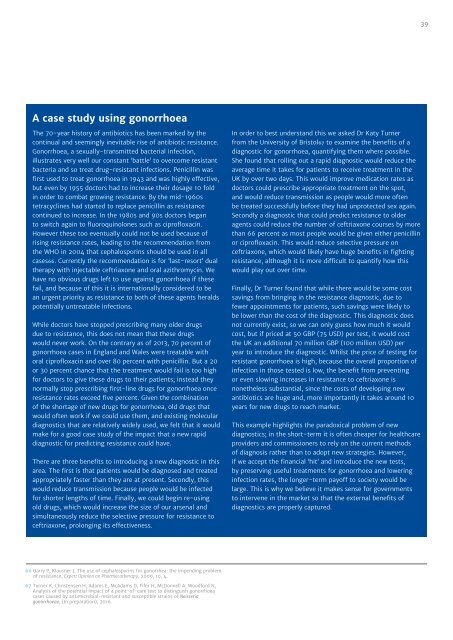TACKLING DRUG-RESISTANT INFECTIONS GLOBALLY FINAL REPORT AND RECOMMENDATIONS
qQvJ300ETXu
qQvJ300ETXu
You also want an ePaper? Increase the reach of your titles
YUMPU automatically turns print PDFs into web optimized ePapers that Google loves.
39<br />
A case study using gonorrhoea<br />
The 70-year history of antibiotics has been marked by the<br />
continual and seemingly inevitable rise of antibiotic resistance.<br />
Gonorrhoea, a sexually-transmitted bacterial infection,<br />
illustrates very well our constant ‘battle’ to overcome resistant<br />
bacteria and so treat drug-resistant infections. Penicillin was<br />
first used to treat gonorrhoea in 1943 and was highly effective,<br />
but even by 1955 doctors had to increase their dosage 10 fold<br />
in order to combat growing resistance. By the mid-1960s<br />
tetracyclines had started to replace penicillin as resistance<br />
continued to increase. In the 1980s and 90s doctors began<br />
to switch again to fluoroquinolones such as ciprofloxacin.<br />
However these too eventually could not be used because of<br />
rising resistance rates, leading to the recommendation from<br />
the WHO in 2004 that cephalosporins should be used in all<br />
cases66. Currently the recommendation is for ‘last-resort’ dual<br />
therapy with injectable ceftriaxone and oral azithromycin. We<br />
have no obvious drugs left to use against gonorrhoea if these<br />
fail, and because of this it is internationally considered to be<br />
an urgent priority as resistance to both of these agents heralds<br />
potentially untreatable infections.<br />
While doctors have stopped prescribing many older drugs<br />
due to resistance, this does not mean that these drugs<br />
would never work. On the contrary as of 2013, 70 percent of<br />
gonorrhoea cases in England and Wales were treatable with<br />
oral ciprofloxacin and over 80 percent with penicillin. But a 20<br />
or 30 percent chance that the treatment would fail is too high<br />
for doctors to give these drugs to their patients; instead they<br />
normally stop prescribing first-line drugs for gonorrhoea once<br />
resistance rates exceed five percent. Given the combination<br />
of the shortage of new drugs for gonorrhoea, old drugs that<br />
would often work if we could use them, and existing molecular<br />
diagnostics that are relatively widely used, we felt that it would<br />
make for a good case study of the impact that a new rapid<br />
diagnostic for predicting resistance could have.<br />
There are three benefits to introducing a new diagnostic in this<br />
area. The first is that patients would be diagnosed and treated<br />
appropriately faster than they are at present. Secondly, this<br />
would reduce transmission because people would be infected<br />
for shorter lengths of time. Finally, we could begin re-using<br />
old drugs, which would increase the size of our arsenal and<br />
simultaneously reduce the selective pressure for resistance to<br />
ceftriaxone, prolonging its effectiveness.<br />
In order to best understand this we asked Dr Katy Turner<br />
from the University of Bristol67 to examine the benefits of a<br />
diagnostic for gonorrhoea, quantifying them where possible.<br />
She found that rolling out a rapid diagnostic would reduce the<br />
average time it takes for patients to receive treatment in the<br />
UK by over two days. This would improve medication rates as<br />
doctors could prescribe appropriate treatment on the spot,<br />
and would reduce transmission as people would more often<br />
be treated successfully before they had unprotected sex again.<br />
Secondly a diagnostic that could predict resistance to older<br />
agents could reduce the number of ceftriaxone courses by more<br />
than 66 percent as most people would be given either penicillin<br />
or ciprofloxacin. This would reduce selective pressure on<br />
ceftriaxone, which would likely have huge benefits in fighting<br />
resistance, although it is more difficult to quantify how this<br />
would play out over time.<br />
Finally, Dr Turner found that while there would be some cost<br />
savings from bringing in the resistance diagnostic, due to<br />
fewer appointments for patients, such savings were likely to<br />
be lower than the cost of the diagnostic. This diagnostic does<br />
not currently exist, so we can only guess how much it would<br />
cost, but if priced at 50 GBP (75 USD) per test, it would cost<br />
the UK an additional 70 million GBP (100 million USD) per<br />
year to introduce the diagnostic. Whilst the price of testing for<br />
resistant gonorrhoea is high, because the overall proportion of<br />
infection in those tested is low, the benefit from preventing<br />
or even slowing increases in resistance to ceftriaxone is<br />
nonetheless substantial, since the costs of developing new<br />
antibiotics are huge and, more importantly it takes around 10<br />
years for new drugs to reach market.<br />
This example highlights the paradoxical problem of new<br />
diagnostics; in the short-term it is often cheaper for healthcare<br />
providers and commissioners to rely on the current methods<br />
of diagnosis rather than to adopt new strategies. However,<br />
if we accept the financial ‘hit’ and introduce the new tests,<br />
by preserving useful treatments for gonorrhoea and lowering<br />
infection rates, the longer-term payoff to society would be<br />
large. This is why we believe it makes sense for governments<br />
to intervene in the market so that the external benefits of<br />
diagnostics are properly captured.<br />
66 Barry P, Klausner J, The use of cephalosporins for gonorrhea: the impending problem<br />
of resistance, Expert Opinion on Pharmacotherapy, 2009, 10, 4.<br />
67 Turner K, Christensen H, Adams E, McAdams D, Fifer H, McDonnell A, Woodford N,<br />
Analysis of the potential impact of a point-of-care test to distinguish gonorrhoea<br />
cases caused by antimicrobial-resistant and susceptible strains of Neisseria<br />
gonorrhoeae, (In preparation), 2016.


